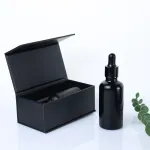Whether a cosmetic can sell well depends not only on its product efficacy, but also on whether its appearance design can attract consumers' attention at the first time. However, many cosmetic brands know little about packaging materials when choosing product packaging. How to make their brands catch customers' attention at the first time is undoubtedly to choose a suitable packaging material and perfect design.
1. Advantages of glass bottles Among cosmetic packaging materials, glass bottles are increasingly recognized by the market because of their significant characteristics. This is mainly because there are several benefits to using glass bottles:
1. Glass material is lead-free and harmless, with good barrier properties, which can well prevent various gases from oxidizing and corroding objects in the bottle, and can effectively prevent the volatile components of the objects inside from volatilizing. 2. Glass bottles can be recycled and used repeatedly, which reduces the packaging cost of enterprises and is also beneficial to environmental protection.
3. The glass is transparent, and the texture of the internal materials is clearly visible. The "appearance + effect" conveys a high-end feeling to consumers.
4. Glass bottles are safe and hygienic, non-toxic and harmless, with good corrosion resistance and acid corrosion resistance, and have special packaging advantages for the cosmetics industry.

2. Application of glass bottles in cosmetics (cream bottles, essences, toners, essential oil bottles)
Glass bottles used in cosmetics are mainly divided into: skin care products (creams, lotions), foundations, perfumes, essential oils, and nail polishes. Bottles with a capacity greater than 200ml are rarely used in cosmetics.
Glass bottles are divided into wide-mouth bottles and narrow-mouth bottles.
Solid pastes are generally made of wide-mouth bottles, which are preferably equipped with electroplated aluminum caps or plastic caps. The bottle caps can be used for color spraying and other effects, such as cream bottles, mask bottles and other commonly used wide-mouth bottles;
Emulsions or aqueous pastes are generally made of narrow-mouth bottles, which are preferably equipped with pump heads. If equipped with caps, they need to be equipped with inner plugs to prevent leakage. Aqueous agents are equipped with small-hole inner plugs, and thicker lotions are equipped with large-hole inner plugs.
Essential oil bottles are usually brown or colored frosted, which can avoid light. The caps have safety rings and can be equipped with inner plugs or droppers. Perfume bottles are generally equipped with exquisite spray pump heads or plastic caps.
The combination forms are as follows:
1. Cream bottle series: glass bottle + double-layer plastic outer cover (generally 10g-50g capacity)
2. Essence series: glass bottle + plastic pump head or electroplated aluminum pump head (generally 20 to 100ml capacity)
3. Toner series: glass bottle + plastic inner plug + outer cover (more than 100ml, there are also those with pump heads)
4. Essential oil bottle series: glass bottle + inner plug + big head cover or rubber head + dropper + electroplated aluminum cover
III. Cosmetic glass bottle processing technology and coloring technology
1. Electroplated aluminum: aluminum appearance, just a layer of film wrapped on the inner layer of plastic.
2. Electroplating (UV): Compared with spraying, the effect is bright.
3. Spraying: Compared with electroplating, the color is dull. Inner bottle and outer spray: spraying is done on the outside of the inner bottle. From the outside, there is a clear gap between the inner bottle and the outer bottle, and the spraying area is small from the side. Spraying inside the outer bottle: spraying on the inner side of the outer bottle, which looks larger from the outside, smaller from the vertical plane, and has no gap with the inner bottle.
4. Drawing gold and silver: It is actually a film. If you look carefully, you can find the gaps connecting the bottle.
5. Secondary oxidation: secondary oxidation is carried out on the original oxide layer, so that the glossy surface is covered with a dull surface pattern or the dull surface has a glossy surface pattern, which is mostly used for logo production.
6. Injection color: color powder is added to the raw materials during product injection molding. The process is relatively cheap. Pearl powder can also be added. Adding cornstarch will turn the transparent color of PET into an opaque color.
Printing process
1. Silk screen printing: one is high-temperature ink silk screen printing, which is characterized by not easy to fade, dull color, and purple coloring is difficult to produce. The other is low-temperature ink silk screen printing, which has brighter color and higher requirements for ink, otherwise it is easy to fall off, and attention should be paid to Custom Cosmetic bottle disinfection.
2. Hot stamping: It is a thin layer of paper that is hot stamped on it, so there is no concave and convex feeling of silk screen printing. It is best not to hot stamp directly on PE and PP. It is necessary to perform heat transfer first and then hot stamping, or it can be directly hot stamped with good hot stamping paper.
3. Water transfer: It is an irregular printing process placed in water. The printed texture is inconsistent and the price is more expensive.
4. Thermal transfer: Thermal transfer is mostly used for products with large quantities and complex printing. It is a layer of film attached to the surface and the price is relatively expensive.
5. Offset printing: It is mostly used for aluminum-plastic hoses and all-plastic hoses. If the offset printing is a colored hose, it must be silk screened when it is white. The offset printing will have a base color showing through, and sometimes a layer of bright film or matte film will be attached to the surface of the hose.
Previous: Are Pinch N Cr Exit Bags Worth the Hype?
Next: Maximize Your Brand: Custom Shampoo Sachet Packaging Tips
Comments
Please Join Us to post.
0